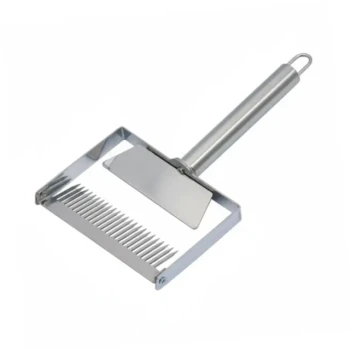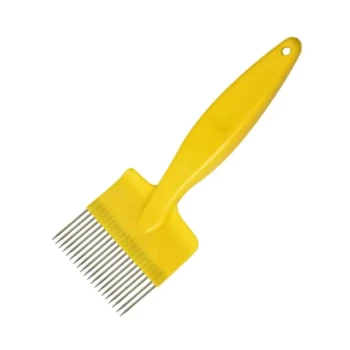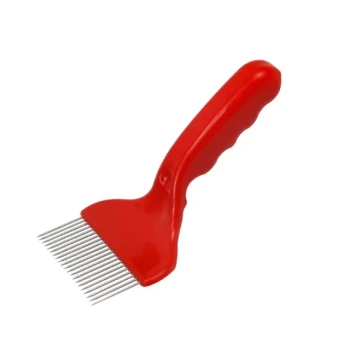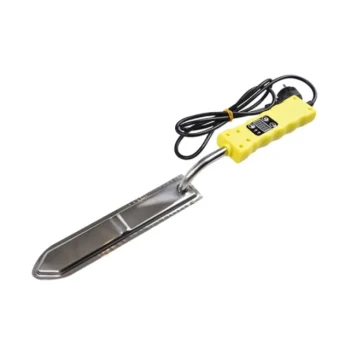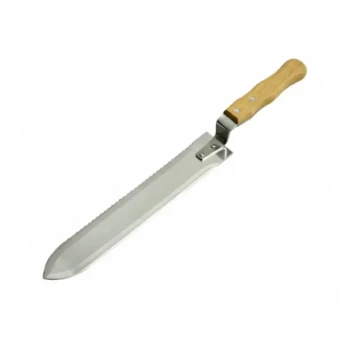To uncap and extract honey, you must first slice off the thin beeswax cappings from the honeycomb using a specialized uncapping knife. Once the cells are open, the frames are placed in a honey extractor, which uses centrifugal force to spin the honey out of the comb without damaging it.
The core of honey extraction is a two-stage process: cleanly removing the protective wax caps from the honeycomb, and then using mechanical force—typically from a spinner—to separate the liquid honey from the comb while maintaining its purity.
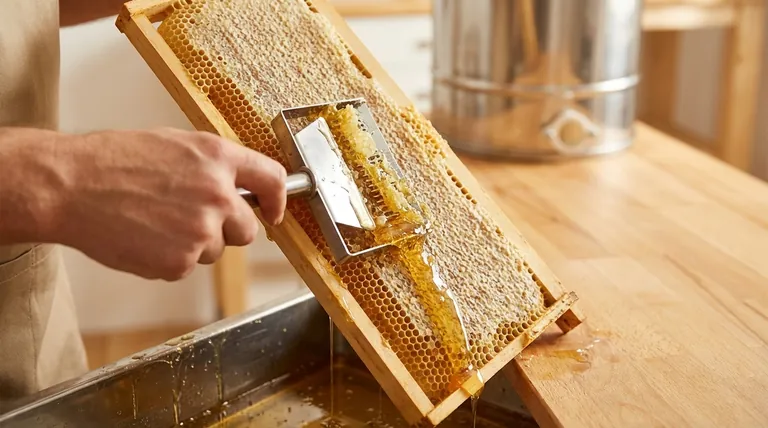
Preparing for a Clean Extraction
A successful harvest depends on preparation. Honey is a food product, and maintaining its quality requires a commitment to cleanliness from start to finish.
Set Up Your Workspace
Your extraction area must be meticulously clean and sealed off from bees, who will be intensely attracted to the smell. Choose a food-safe room with surfaces that are easy to wipe down.
Assemble Your Tools
Before you bring in the honey, have your essential equipment ready. This includes an uncapping knife, a container or tank to catch the wax cappings, a honey extractor, and food-grade buckets with strainers for the final product.
Maintain Strict Hygiene
Treat the process with the same care you would any other food preparation. Ensure your hands and tools are clean, tie back long hair, and avoid any activities that could contaminate the honey.
Step 1: The Art of Uncapping
Uncapping is the most skill-intensive part of the process. The goal is to remove only the wax cappings, leaving the underlying comb structure intact for the bees to reuse.
Choosing Your Uncapping Knife
You have two primary options for uncapping tools.
A heated electric knife contains a heating element that melts through the wax effortlessly, making the process fast and smooth. This is the preferred tool for efficiency.
A cold serrated knife is a less expensive, traditional option. It requires more physical effort to slice through the wax. Dipping the blade in hot water between passes can significantly improve its performance.
The Uncapping Technique
Secure the honey frame vertically, often on a stand that fits over an uncapping tank.
Holding the knife at a slight angle, start at the top of the frame and slice downwards with a gentle, back-and-forth sawing motion. Let the knife's heat or sharpness do the work.
Once the main surfaces are done, use a scratcher or the tip of your knife to open any cells in low spots that the blade missed.
Step 2: Extracting the Honey
With the cells open, you can now separate the honey from the comb. There are two common methods, each with different equipment requirements and outcomes.
Using a Honey Extractor
This is the most common method as it preserves the drawn-out comb. An extractor is a drum that holds the frames and spins them, slinging the honey out against the drum wall via centrifugal force.
Place the uncapped frames into the slots in the extractor. For best results, ensure the load is balanced with frames of similar weight on opposite sides.
Begin spinning slowly and gradually increase the speed. You will need to flip the frames and repeat the process to extract honey from the other side. The honey will collect at the bottom of the extractor, where it can be drained through a gate.
The Crush and Strain Method
If you do not own an extractor, you can use the crush and strain method. This involves cutting the comb out of the frame, crushing it thoroughly to break open all the cells, and placing the resulting mix of wax and honey into a strainer or cheesecloth set over a bucket.
This method is simple and requires minimal equipment, but it destroys the comb, forcing the bees to expend significant energy to rebuild it.
Understanding the Trade-offs
Your choice of method and tools depends on your budget, scale, and long-term goals as a beekeeper.
Extractor vs. Crush and Strain
Using an extractor is a higher initial investment, but it dramatically increases efficiency and, most importantly, saves the bees' comb. This allows the colony to focus on making more honey rather than rebuilding wax infrastructure.
The crush and strain method is inexpensive but labor-intensive and destructive to the comb. It's a viable starting point for a beekeeper with only one or two hives.
Hot Knife vs. Cold Knife
A hot knife makes uncapping significantly faster and easier, reducing torn comb and saving you effort. However, it requires a power source and represents a higher cost.
A cold knife is budget-friendly and requires no electricity. It is perfectly effective but slower and demands more physical technique to avoid damaging the comb.
Making the Right Choice for Your Apiary
Ultimately, your approach should align with the scale of your beekeeping operation and your desired level of investment.
- If your primary focus is a small-scale, budget-friendly harvest: The crush and strain method paired with a simple cold uncapping knife is your most direct path to honey.
- If your primary focus is efficiency and long-term hive productivity: Investing in a honey extractor and a heated uncapping knife will save you time and preserve your valuable drawn comb.
- If your primary focus is producing a premium, unprocessed product: Consider the cut comb method, where sections of capped honeycomb are cut directly from the frame and packaged for consumption, wax and all.
By understanding these core principles and trade-offs, you can confidently and cleanly harvest the sweet results of your bees' hard work.
Summary Table:
| Step | Key Action | Essential Tool(s) |
|---|---|---|
| Preparation | Set up a clean, bee-proof workspace. | Food-grade buckets, strainers. |
| 1. Uncapping | Slice wax cappings off the honeycomb. | Heated or cold uncapping knife. |
| 2. Extraction | Spin honey out or crush and strain the comb. | Honey extractor or cheesecloth. |
Ready to streamline your honey harvest?
For commercial apiaries and distributors, efficiency and comb preservation are key to profitability. HONESTBEE supplies the professional-grade equipment you need—from heated uncapping knives to high-capacity honey extractors—to ensure a clean, efficient, and high-yield harvest season after season.
Contact HONESTBEE today to discuss your wholesale equipment needs and boost your operation's productivity.
Visual Guide
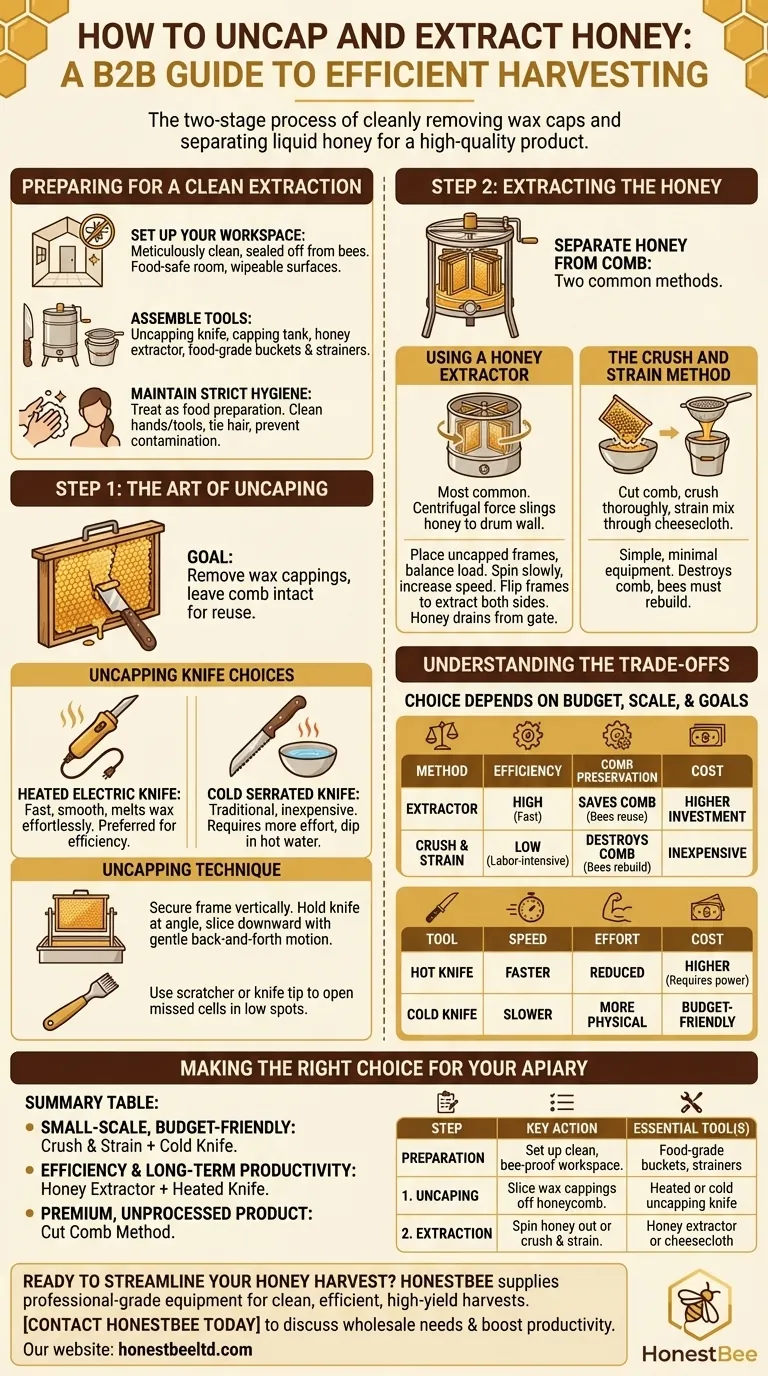
Related Products
- Extra-Wide All-Stainless Steel Honey Uncapping Fork with T-Handle
- Professional Durable Plastic Handle Honey Uncapping Fork
- Professional Wide Head Honey Uncapping Fork for Beekeeping
- Professional Extra-Wide Uncapping Fork with Bent Tines for Beekeeping
- Electric Heated Honey Uncapping Knife for Beekeeping
People Also Ask
- What are the main parts of a honey extractor? A Guide to Efficient Honey Harvesting
- What is the use of an uncapping knife? Master the First Step of Honey Harvesting
- How does an uncapping fork work, and what are its benefits? Achieve Precision Unsealing for Your Honey Frames
- What is the overall recommendation for beginner beekeepers regarding uncapping tools? Master Your First Honey Harvest
- What is the use of an uncapping knife? Essential for a Clean & Efficient Honey Harvest
